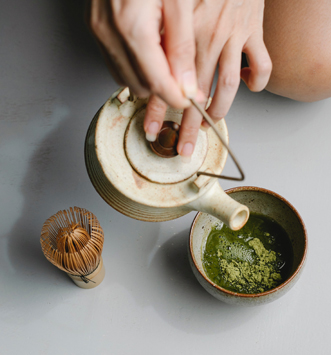
Among the accessories for preparing tea, matcha tea accessories play an important role in the elaboration of this emerald green tea powder, whose origins are intrinsically linked to Buddhism and trade between China and Japan. Matcha tea has a unique taste, multiple health benefits, and promotes meditation.
The matcha tea ceremony: a Japanese tradition for quality tea
Matcha is a green tea powder imported from China to Japan in the 12th century by a Buddhist monk. Its specific preparation, codified by the nobility, is at the origin of the tea ceremony.
Matcha tea is a refined and expensive tea to produce. According to the traditional method still used, the tea leaf is entirely dried and ground in a stone mill. To fully enjoy its many benefits, the preparation of matcha tea relies on three main utensils, both modern and traditional:
- the matcha bowl, or chawan, for preparing and drinking the tea;
- the matcha tea whisk or chasen;
- the matcha tea spoon or chashaku.
The whisk and spoon are made of bamboo, handcrafted artisanally. The accessories allow you to sift, whisk and appreciate this unique green tea. Initially strange, the preparation is simple and easy.
Essential accessories for preparing matcha teas
Matcha teas are not infusions and their preparation differs from that of a more traditional tea. The accessories are the guarantors of quality tea and allow participation in an ancestral elaboration and a unique, soothing, and comforting experience.
- The bowls or cups used for preparing matcha tea preferably have a flat bottom.
- The content of the measuring spoon is generally one gram. This quantity can be sufficient, but tradition is based on two measures of chawan.
- The whisk, the most well-known accessory, exists in different shapes and sizes. Equipped with both fine and rigid bristles, the chasen allows aeration of the tea and creates a creamy foam on the surface of the cup.
- The whisk is often accompanied by a stand (naoshi) that facilitates drying, prevents mold, and extends the life of the whisk.
- The sieve, recommended but not mandatory, makes the powder even finer. Some storage boxes incorporate the sieve.
- The matcha tea container, or natsume, is traditionally made of lacquered wood.
These accessories can be sold separately or as a complete set or kit, ideal for a gift.
Preparing Japanese matcha tea
The preparation of matcha tea is not just dissolving powder in water. The mixture of water and air allows the oxygenation of the tea and the foam obtained on the surface releases unique aromas.
- Use the tea spoon to take a dose of matcha and put it in a tea bowl or chawan.
- Add a small amount of cold water to the bowl to slowly create a lump-free paste with the whisk.
- Add hot water at 70 or 75°C. In any tea preparation, especially green tea, it is important to pay particular attention to the quality and temperature of the water. Boiling water alters the taste of the tea and gives it a certain bitterness.
- Whisk the mixture firmly and energetically with the chasen whisk to obtain a green foam, for about 20 seconds. The movement comes from the wrist and is not circular, but in the shape of a Z or zigzags.
- Enjoy this preparation, preferably with wagashi or small Japanese pastries.
The use of matcha tea in derivative products
Matcha tea is both an exceptional and popular tea recognized for its health benefits and increased concentration abilities during meditation. The use of this subtle tea is found in several derivative products (ice cream, cookies, etc.) and numerous culinary recipes.
Kyoto is the ideal city to discover the origins of matcha tea and the tea ceremony. Without going to Japan, you can nevertheless travel and live this unique experience by equipping yourself with traditional utensils, quality tea, and following the essential steps for its preparation. Follow in the footsteps of the preparation and matcha tea accessories, in a country of traditions amidst intense aromas!
We recommend these other pages: